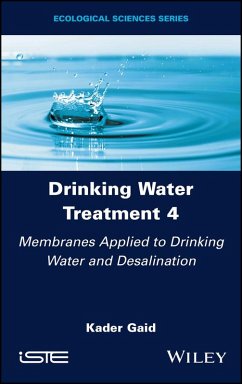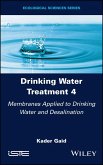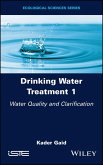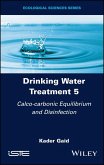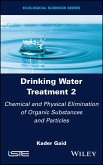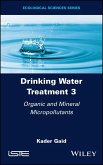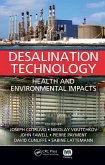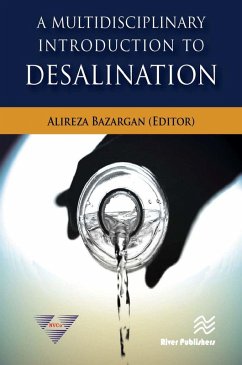Kader Gaid
Drinking Water Treatment, Volume 4, Membranes Applied to Drinking Water and Desalination (eBook, PDF)
142,99 €
142,99 €
inkl. MwSt.
Sofort per Download lieferbar

0 °P sammeln
142,99 €
Als Download kaufen

142,99 €
inkl. MwSt.
Sofort per Download lieferbar

0 °P sammeln
Jetzt verschenken
Alle Infos zum eBook verschenken
142,99 €
inkl. MwSt.
Sofort per Download lieferbar
Alle Infos zum eBook verschenken

0 °P sammeln
Kader Gaid
Drinking Water Treatment, Volume 4, Membranes Applied to Drinking Water and Desalination (eBook, PDF)
- Format: PDF
- Merkliste
- Auf die Merkliste
- Bewerten Bewerten
- Teilen
- Produkt teilen
- Produkterinnerung
- Produkterinnerung

Bitte loggen Sie sich zunächst in Ihr Kundenkonto ein oder registrieren Sie sich bei
bücher.de, um das eBook-Abo tolino select nutzen zu können.
Hier können Sie sich einloggen
Hier können Sie sich einloggen
Sie sind bereits eingeloggt. Klicken Sie auf 2. tolino select Abo, um fortzufahren.

Bitte loggen Sie sich zunächst in Ihr Kundenkonto ein oder registrieren Sie sich bei bücher.de, um das eBook-Abo tolino select nutzen zu können.
- Geräte: PC
- mit Kopierschutz
- eBook Hilfe
- Größe: 53.79MB
Andere Kunden interessierten sich auch für
![Drinking Water Treatment, Volume 4, Membranes Applied to Drinking Water and Desalination (eBook, ePUB) Drinking Water Treatment, Volume 4, Membranes Applied to Drinking Water and Desalination (eBook, ePUB)]() Kader GaidDrinking Water Treatment, Volume 4, Membranes Applied to Drinking Water and Desalination (eBook, ePUB)142,99 €
Kader GaidDrinking Water Treatment, Volume 4, Membranes Applied to Drinking Water and Desalination (eBook, ePUB)142,99 €![Drinking Water Treatment, Volume 1, Water Quality and Clarification (eBook, PDF) Drinking Water Treatment, Volume 1, Water Quality and Clarification (eBook, PDF)]() Kader GaidDrinking Water Treatment, Volume 1, Water Quality and Clarification (eBook, PDF)142,99 €
Kader GaidDrinking Water Treatment, Volume 1, Water Quality and Clarification (eBook, PDF)142,99 €![Drinking Water Treatment, Volume 5, Calco-carbonic Equilibrium and Disinfection (eBook, PDF) Drinking Water Treatment, Volume 5, Calco-carbonic Equilibrium and Disinfection (eBook, PDF)]() Kader GaidDrinking Water Treatment, Volume 5, Calco-carbonic Equilibrium and Disinfection (eBook, PDF)142,99 €
Kader GaidDrinking Water Treatment, Volume 5, Calco-carbonic Equilibrium and Disinfection (eBook, PDF)142,99 €![Drinking Water Treatment, Volume 2, Chemical and Physical Elimination of Organic Substances and Particles (eBook, PDF) Drinking Water Treatment, Volume 2, Chemical and Physical Elimination of Organic Substances and Particles (eBook, PDF)]() Kader GaidDrinking Water Treatment, Volume 2, Chemical and Physical Elimination of Organic Substances and Particles (eBook, PDF)142,99 €
Kader GaidDrinking Water Treatment, Volume 2, Chemical and Physical Elimination of Organic Substances and Particles (eBook, PDF)142,99 €![Drinking Water Treatment, Volume 3, Organic and Mineral Micropollutants (eBook, PDF) Drinking Water Treatment, Volume 3, Organic and Mineral Micropollutants (eBook, PDF)]() Kader GaidDrinking Water Treatment, Volume 3, Organic and Mineral Micropollutants (eBook, PDF)142,99 €
Kader GaidDrinking Water Treatment, Volume 3, Organic and Mineral Micropollutants (eBook, PDF)142,99 €![Desalination Technology (eBook, PDF) Desalination Technology (eBook, PDF)]() Desalination Technology (eBook, PDF)52,95 €
Desalination Technology (eBook, PDF)52,95 €![Multidisciplinary Introduction to Desalination (eBook, PDF) Multidisciplinary Introduction to Desalination (eBook, PDF)]() Multidisciplinary Introduction to Desalination (eBook, PDF)67,95 €
Multidisciplinary Introduction to Desalination (eBook, PDF)67,95 €-
-
-
Produktdetails
- Verlag: John Wiley & Sons
- Seitenzahl: 416
- Erscheinungstermin: 29. Juni 2023
- Englisch
- ISBN-13: 9781394226115
- Artikelnr.: 68456123
Dieser Download kann aus rechtlichen Gründen nur mit Rechnungsadresse in A, B, BG, CY, CZ, D, DK, EW, E, FIN, F, GR, HR, H, IRL, I, LT, L, LR, M, NL, PL, P, R, S, SLO, SK ausgeliefert werden.
- Herstellerkennzeichnung Die Herstellerinformationen sind derzeit nicht verfügbar.
Kader Gaid is a doctor of physical sciences, specifically environmental process engineering. A professor and researcher at the Alger University of Science and Technology Houari Boumédiène (Algeria), he has been an expert in drinking water at the worldwide company Veolia for over 25 years.
Chapter 17 Microfiltration and Ultrafiltration 1
17.1 UF and MF: cut-off 2
17.2 UF and MF: materials 6
17.2.1 Cellulose acetate 6
17.2.2 Polypropylene 7
17.2.3 Polyacrylonitrile 7
17.2.4 Polyether sulfone/polysulfone 7
17.2.5 Polyvinylidene fluoride 8
17.3 UF and MF: membrane types 8
17.4 UF and MF: implementation of membranes under pressure 11
17.4.1 Horizontal-vertical configuration 13
17.4.2 Submerged membranes 17
17.5 Filtration modes: frontal or tangential 19
17.5.1 Batch operation: filtration-backwash 21
17.5.2 Filtration direction 21
17.6 Sizing parameters: membrane selection 22
17.7 Sizing parameters: horizontal or vertical configuration 25
17.8 Sizing parameters: flow 25
17.8.1 Instantaneous flow and net flow 26
17.8.2 Transmembrane pressure 31
17.8.3 Resistance 33
17.8.4 Permeability 33
17.8.5 Principle of the calculation of the membrane surface and water
losses 35
17.8.6 Pre-filters 37
17.9 Operating parameters 37
17.9.1 Evolution of the permeability 37
17.9.2 Clogging 38
17.9.3 Frequency and conditions of hydraulic and chemical backwashing 46
17.9.4 Frequency and conditions of CIP 53
17.9.5 Membrane integrity 56
17.10 MF and UF's place in a treatment process 62
17.10.1 Turbidity and SS 63
17.10.2 TOC (and UV254) 63
17.10.3 Algae 63
17.10.4 Iron and manganese 63
17.11 Combination of coagulation and UF membranes 71
17.12 Combination of PAC and UF 75
17.13 Performance and guarantees 76
17.13.1 Turbidity 76
17.13.2 Supplier warranty on the life of the membranes 86
17.14 Advantages of MF and UF 87
17.15 Veolia's experience 87
17.16 Appendix: sheets 92
17.17 References 107
Chapter 18 Nanofiltration and Reverse Osmosis 111
18.1 Membranes 112
18.1.1 Materials 112
18.1.2 Membrane element configurations 115
18.2 Principles of operation and separation 119
18.2.1 Conceptual principle 119
18.2.2 Molecular weight cut-off 124
18.3 Treatment process including high-pressure membranes and parameters to
be considered 127
18.3.1 Particulates and SS 127
18.3.2 Particle count 128
18.3.3 Conductivity 128
18.3.4 The SDI or MFI: clogging indices 128
18.3.5 The SDI 128
18.3.6 The MFI 130
18.3.7 Salts and metals 131
18.3.8 Biological clogging 132
18.3.9 Undesirable substances 133
18.3.10 Limit values of compounds at the inlet of high-pressure membranes
133
18.4 Sizing parameters 134
18.4.1 Temperature 134
18.4.2 Implementation configuration 134
18.4.3 Calculation of the osmotic pressure 138
18.4.4 Mass flow diagram 139
18.4.5 Salt passage 140
18.4.6 Concentration factor 140
18.4.7 Hydraulic pressure loss 140
18.4.8 Pressure tubes and number of modules per tube 141
18.5 Chemical conditioning of pre-treated water 143
18.5.1 Calculation of saturation indices and antiscalant dosage 143
18.5.2 Choice and implementation of the antiscalant 146
18.5.3 pH adjustment at the membrane inlet 147
18.5.4 Choice and application of the acid 148
18.5.5 Influence of sulfates 148
18.6 Design and implementation 148
18.6.1 Pre-treatment 148
18.6.2 Treatment processes 149
18.6.3 Membrane station 152
18.6.4 Post-treatment 158
18.6.5 Cleaning units in place 159
18.7 Functional and operating parameters 162
18.7.1 Basic principles 162
18.7.2 Permeability (Lp) 166
18.7.3 Longitudinal pressure drop (¿Pfc) 166
18.7.4 Hydraulic resistance 167
18.7.5 Energy 167
18.7.6 Sdi 168
18.7.7 Chemical cleaning 168
18.7.8 The fate of concentrates and used washing solutions 168
18.7.9 Methods for assessing the impact of concentrate discharges in the
natural environment 171
18.8 High-pressure membrane performance 174
18.8.1 Organic matter 175
18.8.2 Pesticides, drug residues, endocrine disruptors and industrial
residues 176
18.8.3 Various toxic and undesirable substances 177
18.8.4 Salts 177
18.8.5 Micro-organisms 178
18.8.6 Overall performance 179
18.9 Lifetime warranties 179
18.10 Parameters affecting the performance of NF membranes 180
18.10.1 Taking clogging into account 181
18.11 Monitoring and control parameters: standardization of raw data 182
18.12 Veolia's experience: examples of treatment processes 184
18.12.1 Surface water No 1 184
18.12.2 Surface water No 2 188
18.12.3 Groundwater No 1 193
18.12.4 Groundwater No 2 195
18.13 References 200
Chapter 19 Desalination by Reverse Osmosis 205
19.1 Characterization of the water to be treated 205
19.1.1 Physical characteristics 207
19.1.2 Chemical composition: ionic content 214
19.1.3 Chemical composition: organic substances 224
19.2 Fields of application 234
19.3 Operating principle of RO 234
19.4 The membranes used in desalination 237
19.5 Sizing parameters 238
19.5.1 Flow 239
19.5.2 Concentration polarization 240
19.5.3 Conversion rate 240
19.5.4 Passage rate and rejection rate in salts 241
19.5.5 Influence of the temperature 242
19.5.6 Determining the number of modules and pressure tubes 243
19.6 Implementation 244
19.6.1 Membranes 244
19.6.2 Pressure tube 245
19.6.3 Pass 246
19.7 Pre-treatment 246
19.7.1 Pre-treatment selection 246
19.7.2 Pre-treatment systems 250
19.8 Pre-chlorination 254
19.8.1 Pre-chlorination and development of micro- and macro-organisms 254
19.8.2 Implementation of chlorination 257
19.8.3 pH adjustment 263
19.8.4 Direct filtration 263
19.8.5 Chemical conditions of implementation 273
19.8.6 Flotation 276
19.8.7 Settling 281
19.8.8 Membranes (UF and MF) 282
19.8.9 Conclusions on pre-treatment with UF membranes 291
19.9 Energy consumption 292
19.9.1 Energy consumption without recovery 292
19.9.2 Energy consumption with recovery 293
19.9.3 Hydraulic exchanger systems 293
19.10 Operating parameters 305
19.10.1 Relationship between conductivity and salt concentration 305
19.10.2 Controlling RO membrane clogging 306
19.11 Performance of RO membranes used in desalination 307
19.11.1 Boron removal 307
19.12 Post-treatment 315
19.12.1 Indicators characterizing the aggressiveness or corrosiveness of
the water 317
19.12.2 Application to desalinated water 320
19.12.3 Treatments 322
19.13 Monitoring and control parameters 336
19.13.1 Standardization of raw data 336
19.13.2 Bromates 338
19.14 Veolia's new processes applied to seawater desalination 339
19.14.1 Flotation with the Spidflow® process 339
19.14.2 Spidflow® filter process applied to seawater desalination 344
19.14.3 BiopROtector 349
19.14.4 Barrel (SIDEM Veolia) 353
19.14.5 Hiprode 355
19.15 Packaged solutions in desalination 358
19.16 Veolia's experience (HP membranes) 360
19.17 References 374
Index 385
Summaries of other volumes 387
17.1 UF and MF: cut-off 2
17.2 UF and MF: materials 6
17.2.1 Cellulose acetate 6
17.2.2 Polypropylene 7
17.2.3 Polyacrylonitrile 7
17.2.4 Polyether sulfone/polysulfone 7
17.2.5 Polyvinylidene fluoride 8
17.3 UF and MF: membrane types 8
17.4 UF and MF: implementation of membranes under pressure 11
17.4.1 Horizontal-vertical configuration 13
17.4.2 Submerged membranes 17
17.5 Filtration modes: frontal or tangential 19
17.5.1 Batch operation: filtration-backwash 21
17.5.2 Filtration direction 21
17.6 Sizing parameters: membrane selection 22
17.7 Sizing parameters: horizontal or vertical configuration 25
17.8 Sizing parameters: flow 25
17.8.1 Instantaneous flow and net flow 26
17.8.2 Transmembrane pressure 31
17.8.3 Resistance 33
17.8.4 Permeability 33
17.8.5 Principle of the calculation of the membrane surface and water
losses 35
17.8.6 Pre-filters 37
17.9 Operating parameters 37
17.9.1 Evolution of the permeability 37
17.9.2 Clogging 38
17.9.3 Frequency and conditions of hydraulic and chemical backwashing 46
17.9.4 Frequency and conditions of CIP 53
17.9.5 Membrane integrity 56
17.10 MF and UF's place in a treatment process 62
17.10.1 Turbidity and SS 63
17.10.2 TOC (and UV254) 63
17.10.3 Algae 63
17.10.4 Iron and manganese 63
17.11 Combination of coagulation and UF membranes 71
17.12 Combination of PAC and UF 75
17.13 Performance and guarantees 76
17.13.1 Turbidity 76
17.13.2 Supplier warranty on the life of the membranes 86
17.14 Advantages of MF and UF 87
17.15 Veolia's experience 87
17.16 Appendix: sheets 92
17.17 References 107
Chapter 18 Nanofiltration and Reverse Osmosis 111
18.1 Membranes 112
18.1.1 Materials 112
18.1.2 Membrane element configurations 115
18.2 Principles of operation and separation 119
18.2.1 Conceptual principle 119
18.2.2 Molecular weight cut-off 124
18.3 Treatment process including high-pressure membranes and parameters to
be considered 127
18.3.1 Particulates and SS 127
18.3.2 Particle count 128
18.3.3 Conductivity 128
18.3.4 The SDI or MFI: clogging indices 128
18.3.5 The SDI 128
18.3.6 The MFI 130
18.3.7 Salts and metals 131
18.3.8 Biological clogging 132
18.3.9 Undesirable substances 133
18.3.10 Limit values of compounds at the inlet of high-pressure membranes
133
18.4 Sizing parameters 134
18.4.1 Temperature 134
18.4.2 Implementation configuration 134
18.4.3 Calculation of the osmotic pressure 138
18.4.4 Mass flow diagram 139
18.4.5 Salt passage 140
18.4.6 Concentration factor 140
18.4.7 Hydraulic pressure loss 140
18.4.8 Pressure tubes and number of modules per tube 141
18.5 Chemical conditioning of pre-treated water 143
18.5.1 Calculation of saturation indices and antiscalant dosage 143
18.5.2 Choice and implementation of the antiscalant 146
18.5.3 pH adjustment at the membrane inlet 147
18.5.4 Choice and application of the acid 148
18.5.5 Influence of sulfates 148
18.6 Design and implementation 148
18.6.1 Pre-treatment 148
18.6.2 Treatment processes 149
18.6.3 Membrane station 152
18.6.4 Post-treatment 158
18.6.5 Cleaning units in place 159
18.7 Functional and operating parameters 162
18.7.1 Basic principles 162
18.7.2 Permeability (Lp) 166
18.7.3 Longitudinal pressure drop (¿Pfc) 166
18.7.4 Hydraulic resistance 167
18.7.5 Energy 167
18.7.6 Sdi 168
18.7.7 Chemical cleaning 168
18.7.8 The fate of concentrates and used washing solutions 168
18.7.9 Methods for assessing the impact of concentrate discharges in the
natural environment 171
18.8 High-pressure membrane performance 174
18.8.1 Organic matter 175
18.8.2 Pesticides, drug residues, endocrine disruptors and industrial
residues 176
18.8.3 Various toxic and undesirable substances 177
18.8.4 Salts 177
18.8.5 Micro-organisms 178
18.8.6 Overall performance 179
18.9 Lifetime warranties 179
18.10 Parameters affecting the performance of NF membranes 180
18.10.1 Taking clogging into account 181
18.11 Monitoring and control parameters: standardization of raw data 182
18.12 Veolia's experience: examples of treatment processes 184
18.12.1 Surface water No 1 184
18.12.2 Surface water No 2 188
18.12.3 Groundwater No 1 193
18.12.4 Groundwater No 2 195
18.13 References 200
Chapter 19 Desalination by Reverse Osmosis 205
19.1 Characterization of the water to be treated 205
19.1.1 Physical characteristics 207
19.1.2 Chemical composition: ionic content 214
19.1.3 Chemical composition: organic substances 224
19.2 Fields of application 234
19.3 Operating principle of RO 234
19.4 The membranes used in desalination 237
19.5 Sizing parameters 238
19.5.1 Flow 239
19.5.2 Concentration polarization 240
19.5.3 Conversion rate 240
19.5.4 Passage rate and rejection rate in salts 241
19.5.5 Influence of the temperature 242
19.5.6 Determining the number of modules and pressure tubes 243
19.6 Implementation 244
19.6.1 Membranes 244
19.6.2 Pressure tube 245
19.6.3 Pass 246
19.7 Pre-treatment 246
19.7.1 Pre-treatment selection 246
19.7.2 Pre-treatment systems 250
19.8 Pre-chlorination 254
19.8.1 Pre-chlorination and development of micro- and macro-organisms 254
19.8.2 Implementation of chlorination 257
19.8.3 pH adjustment 263
19.8.4 Direct filtration 263
19.8.5 Chemical conditions of implementation 273
19.8.6 Flotation 276
19.8.7 Settling 281
19.8.8 Membranes (UF and MF) 282
19.8.9 Conclusions on pre-treatment with UF membranes 291
19.9 Energy consumption 292
19.9.1 Energy consumption without recovery 292
19.9.2 Energy consumption with recovery 293
19.9.3 Hydraulic exchanger systems 293
19.10 Operating parameters 305
19.10.1 Relationship between conductivity and salt concentration 305
19.10.2 Controlling RO membrane clogging 306
19.11 Performance of RO membranes used in desalination 307
19.11.1 Boron removal 307
19.12 Post-treatment 315
19.12.1 Indicators characterizing the aggressiveness or corrosiveness of
the water 317
19.12.2 Application to desalinated water 320
19.12.3 Treatments 322
19.13 Monitoring and control parameters 336
19.13.1 Standardization of raw data 336
19.13.2 Bromates 338
19.14 Veolia's new processes applied to seawater desalination 339
19.14.1 Flotation with the Spidflow® process 339
19.14.2 Spidflow® filter process applied to seawater desalination 344
19.14.3 BiopROtector 349
19.14.4 Barrel (SIDEM Veolia) 353
19.14.5 Hiprode 355
19.15 Packaged solutions in desalination 358
19.16 Veolia's experience (HP membranes) 360
19.17 References 374
Index 385
Summaries of other volumes 387
Chapter 17 Microfiltration and Ultrafiltration 1
17.1 UF and MF: cut-off 2
17.2 UF and MF: materials 6
17.2.1 Cellulose acetate 6
17.2.2 Polypropylene 7
17.2.3 Polyacrylonitrile 7
17.2.4 Polyether sulfone/polysulfone 7
17.2.5 Polyvinylidene fluoride 8
17.3 UF and MF: membrane types 8
17.4 UF and MF: implementation of membranes under pressure 11
17.4.1 Horizontal-vertical configuration 13
17.4.2 Submerged membranes 17
17.5 Filtration modes: frontal or tangential 19
17.5.1 Batch operation: filtration-backwash 21
17.5.2 Filtration direction 21
17.6 Sizing parameters: membrane selection 22
17.7 Sizing parameters: horizontal or vertical configuration 25
17.8 Sizing parameters: flow 25
17.8.1 Instantaneous flow and net flow 26
17.8.2 Transmembrane pressure 31
17.8.3 Resistance 33
17.8.4 Permeability 33
17.8.5 Principle of the calculation of the membrane surface and water
losses 35
17.8.6 Pre-filters 37
17.9 Operating parameters 37
17.9.1 Evolution of the permeability 37
17.9.2 Clogging 38
17.9.3 Frequency and conditions of hydraulic and chemical backwashing 46
17.9.4 Frequency and conditions of CIP 53
17.9.5 Membrane integrity 56
17.10 MF and UF's place in a treatment process 62
17.10.1 Turbidity and SS 63
17.10.2 TOC (and UV254) 63
17.10.3 Algae 63
17.10.4 Iron and manganese 63
17.11 Combination of coagulation and UF membranes 71
17.12 Combination of PAC and UF 75
17.13 Performance and guarantees 76
17.13.1 Turbidity 76
17.13.2 Supplier warranty on the life of the membranes 86
17.14 Advantages of MF and UF 87
17.15 Veolia's experience 87
17.16 Appendix: sheets 92
17.17 References 107
Chapter 18 Nanofiltration and Reverse Osmosis 111
18.1 Membranes 112
18.1.1 Materials 112
18.1.2 Membrane element configurations 115
18.2 Principles of operation and separation 119
18.2.1 Conceptual principle 119
18.2.2 Molecular weight cut-off 124
18.3 Treatment process including high-pressure membranes and parameters to
be considered 127
18.3.1 Particulates and SS 127
18.3.2 Particle count 128
18.3.3 Conductivity 128
18.3.4 The SDI or MFI: clogging indices 128
18.3.5 The SDI 128
18.3.6 The MFI 130
18.3.7 Salts and metals 131
18.3.8 Biological clogging 132
18.3.9 Undesirable substances 133
18.3.10 Limit values of compounds at the inlet of high-pressure membranes
133
18.4 Sizing parameters 134
18.4.1 Temperature 134
18.4.2 Implementation configuration 134
18.4.3 Calculation of the osmotic pressure 138
18.4.4 Mass flow diagram 139
18.4.5 Salt passage 140
18.4.6 Concentration factor 140
18.4.7 Hydraulic pressure loss 140
18.4.8 Pressure tubes and number of modules per tube 141
18.5 Chemical conditioning of pre-treated water 143
18.5.1 Calculation of saturation indices and antiscalant dosage 143
18.5.2 Choice and implementation of the antiscalant 146
18.5.3 pH adjustment at the membrane inlet 147
18.5.4 Choice and application of the acid 148
18.5.5 Influence of sulfates 148
18.6 Design and implementation 148
18.6.1 Pre-treatment 148
18.6.2 Treatment processes 149
18.6.3 Membrane station 152
18.6.4 Post-treatment 158
18.6.5 Cleaning units in place 159
18.7 Functional and operating parameters 162
18.7.1 Basic principles 162
18.7.2 Permeability (Lp) 166
18.7.3 Longitudinal pressure drop (¿Pfc) 166
18.7.4 Hydraulic resistance 167
18.7.5 Energy 167
18.7.6 Sdi 168
18.7.7 Chemical cleaning 168
18.7.8 The fate of concentrates and used washing solutions 168
18.7.9 Methods for assessing the impact of concentrate discharges in the
natural environment 171
18.8 High-pressure membrane performance 174
18.8.1 Organic matter 175
18.8.2 Pesticides, drug residues, endocrine disruptors and industrial
residues 176
18.8.3 Various toxic and undesirable substances 177
18.8.4 Salts 177
18.8.5 Micro-organisms 178
18.8.6 Overall performance 179
18.9 Lifetime warranties 179
18.10 Parameters affecting the performance of NF membranes 180
18.10.1 Taking clogging into account 181
18.11 Monitoring and control parameters: standardization of raw data 182
18.12 Veolia's experience: examples of treatment processes 184
18.12.1 Surface water No 1 184
18.12.2 Surface water No 2 188
18.12.3 Groundwater No 1 193
18.12.4 Groundwater No 2 195
18.13 References 200
Chapter 19 Desalination by Reverse Osmosis 205
19.1 Characterization of the water to be treated 205
19.1.1 Physical characteristics 207
19.1.2 Chemical composition: ionic content 214
19.1.3 Chemical composition: organic substances 224
19.2 Fields of application 234
19.3 Operating principle of RO 234
19.4 The membranes used in desalination 237
19.5 Sizing parameters 238
19.5.1 Flow 239
19.5.2 Concentration polarization 240
19.5.3 Conversion rate 240
19.5.4 Passage rate and rejection rate in salts 241
19.5.5 Influence of the temperature 242
19.5.6 Determining the number of modules and pressure tubes 243
19.6 Implementation 244
19.6.1 Membranes 244
19.6.2 Pressure tube 245
19.6.3 Pass 246
19.7 Pre-treatment 246
19.7.1 Pre-treatment selection 246
19.7.2 Pre-treatment systems 250
19.8 Pre-chlorination 254
19.8.1 Pre-chlorination and development of micro- and macro-organisms 254
19.8.2 Implementation of chlorination 257
19.8.3 pH adjustment 263
19.8.4 Direct filtration 263
19.8.5 Chemical conditions of implementation 273
19.8.6 Flotation 276
19.8.7 Settling 281
19.8.8 Membranes (UF and MF) 282
19.8.9 Conclusions on pre-treatment with UF membranes 291
19.9 Energy consumption 292
19.9.1 Energy consumption without recovery 292
19.9.2 Energy consumption with recovery 293
19.9.3 Hydraulic exchanger systems 293
19.10 Operating parameters 305
19.10.1 Relationship between conductivity and salt concentration 305
19.10.2 Controlling RO membrane clogging 306
19.11 Performance of RO membranes used in desalination 307
19.11.1 Boron removal 307
19.12 Post-treatment 315
19.12.1 Indicators characterizing the aggressiveness or corrosiveness of
the water 317
19.12.2 Application to desalinated water 320
19.12.3 Treatments 322
19.13 Monitoring and control parameters 336
19.13.1 Standardization of raw data 336
19.13.2 Bromates 338
19.14 Veolia's new processes applied to seawater desalination 339
19.14.1 Flotation with the Spidflow® process 339
19.14.2 Spidflow® filter process applied to seawater desalination 344
19.14.3 BiopROtector 349
19.14.4 Barrel (SIDEM Veolia) 353
19.14.5 Hiprode 355
19.15 Packaged solutions in desalination 358
19.16 Veolia's experience (HP membranes) 360
19.17 References 374
Index 385
Summaries of other volumes 387
17.1 UF and MF: cut-off 2
17.2 UF and MF: materials 6
17.2.1 Cellulose acetate 6
17.2.2 Polypropylene 7
17.2.3 Polyacrylonitrile 7
17.2.4 Polyether sulfone/polysulfone 7
17.2.5 Polyvinylidene fluoride 8
17.3 UF and MF: membrane types 8
17.4 UF and MF: implementation of membranes under pressure 11
17.4.1 Horizontal-vertical configuration 13
17.4.2 Submerged membranes 17
17.5 Filtration modes: frontal or tangential 19
17.5.1 Batch operation: filtration-backwash 21
17.5.2 Filtration direction 21
17.6 Sizing parameters: membrane selection 22
17.7 Sizing parameters: horizontal or vertical configuration 25
17.8 Sizing parameters: flow 25
17.8.1 Instantaneous flow and net flow 26
17.8.2 Transmembrane pressure 31
17.8.3 Resistance 33
17.8.4 Permeability 33
17.8.5 Principle of the calculation of the membrane surface and water
losses 35
17.8.6 Pre-filters 37
17.9 Operating parameters 37
17.9.1 Evolution of the permeability 37
17.9.2 Clogging 38
17.9.3 Frequency and conditions of hydraulic and chemical backwashing 46
17.9.4 Frequency and conditions of CIP 53
17.9.5 Membrane integrity 56
17.10 MF and UF's place in a treatment process 62
17.10.1 Turbidity and SS 63
17.10.2 TOC (and UV254) 63
17.10.3 Algae 63
17.10.4 Iron and manganese 63
17.11 Combination of coagulation and UF membranes 71
17.12 Combination of PAC and UF 75
17.13 Performance and guarantees 76
17.13.1 Turbidity 76
17.13.2 Supplier warranty on the life of the membranes 86
17.14 Advantages of MF and UF 87
17.15 Veolia's experience 87
17.16 Appendix: sheets 92
17.17 References 107
Chapter 18 Nanofiltration and Reverse Osmosis 111
18.1 Membranes 112
18.1.1 Materials 112
18.1.2 Membrane element configurations 115
18.2 Principles of operation and separation 119
18.2.1 Conceptual principle 119
18.2.2 Molecular weight cut-off 124
18.3 Treatment process including high-pressure membranes and parameters to
be considered 127
18.3.1 Particulates and SS 127
18.3.2 Particle count 128
18.3.3 Conductivity 128
18.3.4 The SDI or MFI: clogging indices 128
18.3.5 The SDI 128
18.3.6 The MFI 130
18.3.7 Salts and metals 131
18.3.8 Biological clogging 132
18.3.9 Undesirable substances 133
18.3.10 Limit values of compounds at the inlet of high-pressure membranes
133
18.4 Sizing parameters 134
18.4.1 Temperature 134
18.4.2 Implementation configuration 134
18.4.3 Calculation of the osmotic pressure 138
18.4.4 Mass flow diagram 139
18.4.5 Salt passage 140
18.4.6 Concentration factor 140
18.4.7 Hydraulic pressure loss 140
18.4.8 Pressure tubes and number of modules per tube 141
18.5 Chemical conditioning of pre-treated water 143
18.5.1 Calculation of saturation indices and antiscalant dosage 143
18.5.2 Choice and implementation of the antiscalant 146
18.5.3 pH adjustment at the membrane inlet 147
18.5.4 Choice and application of the acid 148
18.5.5 Influence of sulfates 148
18.6 Design and implementation 148
18.6.1 Pre-treatment 148
18.6.2 Treatment processes 149
18.6.3 Membrane station 152
18.6.4 Post-treatment 158
18.6.5 Cleaning units in place 159
18.7 Functional and operating parameters 162
18.7.1 Basic principles 162
18.7.2 Permeability (Lp) 166
18.7.3 Longitudinal pressure drop (¿Pfc) 166
18.7.4 Hydraulic resistance 167
18.7.5 Energy 167
18.7.6 Sdi 168
18.7.7 Chemical cleaning 168
18.7.8 The fate of concentrates and used washing solutions 168
18.7.9 Methods for assessing the impact of concentrate discharges in the
natural environment 171
18.8 High-pressure membrane performance 174
18.8.1 Organic matter 175
18.8.2 Pesticides, drug residues, endocrine disruptors and industrial
residues 176
18.8.3 Various toxic and undesirable substances 177
18.8.4 Salts 177
18.8.5 Micro-organisms 178
18.8.6 Overall performance 179
18.9 Lifetime warranties 179
18.10 Parameters affecting the performance of NF membranes 180
18.10.1 Taking clogging into account 181
18.11 Monitoring and control parameters: standardization of raw data 182
18.12 Veolia's experience: examples of treatment processes 184
18.12.1 Surface water No 1 184
18.12.2 Surface water No 2 188
18.12.3 Groundwater No 1 193
18.12.4 Groundwater No 2 195
18.13 References 200
Chapter 19 Desalination by Reverse Osmosis 205
19.1 Characterization of the water to be treated 205
19.1.1 Physical characteristics 207
19.1.2 Chemical composition: ionic content 214
19.1.3 Chemical composition: organic substances 224
19.2 Fields of application 234
19.3 Operating principle of RO 234
19.4 The membranes used in desalination 237
19.5 Sizing parameters 238
19.5.1 Flow 239
19.5.2 Concentration polarization 240
19.5.3 Conversion rate 240
19.5.4 Passage rate and rejection rate in salts 241
19.5.5 Influence of the temperature 242
19.5.6 Determining the number of modules and pressure tubes 243
19.6 Implementation 244
19.6.1 Membranes 244
19.6.2 Pressure tube 245
19.6.3 Pass 246
19.7 Pre-treatment 246
19.7.1 Pre-treatment selection 246
19.7.2 Pre-treatment systems 250
19.8 Pre-chlorination 254
19.8.1 Pre-chlorination and development of micro- and macro-organisms 254
19.8.2 Implementation of chlorination 257
19.8.3 pH adjustment 263
19.8.4 Direct filtration 263
19.8.5 Chemical conditions of implementation 273
19.8.6 Flotation 276
19.8.7 Settling 281
19.8.8 Membranes (UF and MF) 282
19.8.9 Conclusions on pre-treatment with UF membranes 291
19.9 Energy consumption 292
19.9.1 Energy consumption without recovery 292
19.9.2 Energy consumption with recovery 293
19.9.3 Hydraulic exchanger systems 293
19.10 Operating parameters 305
19.10.1 Relationship between conductivity and salt concentration 305
19.10.2 Controlling RO membrane clogging 306
19.11 Performance of RO membranes used in desalination 307
19.11.1 Boron removal 307
19.12 Post-treatment 315
19.12.1 Indicators characterizing the aggressiveness or corrosiveness of
the water 317
19.12.2 Application to desalinated water 320
19.12.3 Treatments 322
19.13 Monitoring and control parameters 336
19.13.1 Standardization of raw data 336
19.13.2 Bromates 338
19.14 Veolia's new processes applied to seawater desalination 339
19.14.1 Flotation with the Spidflow® process 339
19.14.2 Spidflow® filter process applied to seawater desalination 344
19.14.3 BiopROtector 349
19.14.4 Barrel (SIDEM Veolia) 353
19.14.5 Hiprode 355
19.15 Packaged solutions in desalination 358
19.16 Veolia's experience (HP membranes) 360
19.17 References 374
Index 385
Summaries of other volumes 387
